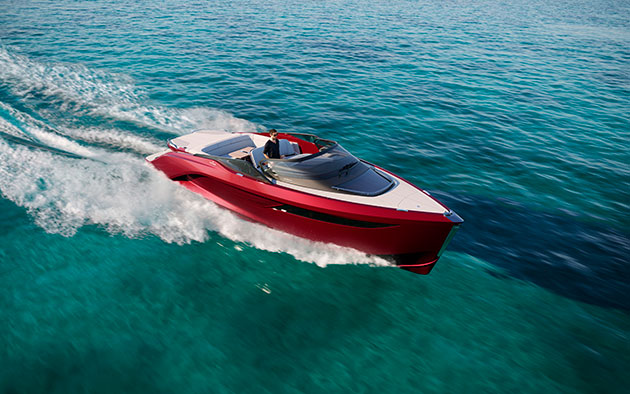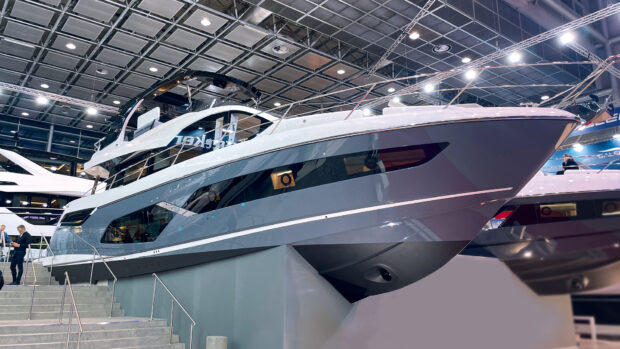Volvo bought an Azimut 68S to test and demonstrate its new self-docking system. Jon Mendez tests the new technology at the Gothenburg stopover of the Volvo Ocean Race
Volvo has long been one of the marine industry’s pioneers, popularising game-changing technology like sterndrive engines, IPS pods and joystick manoeuvring, but its latest innovation could trump them all.
The idea of a self-docking boat won’t just take the stress out of tricky berthing situations, it could also open up boating to millions of people who don’t have the skills or time to go through the learning curve required to berth in challenging conditions.
For the moment the technology is still in the development stage, but with sales of the system due as early as 2020 and a working prototype already on the water, the company took the brave step of showing off its latest invention to a select group
of media, including MBY, at the recent Gothenburg stopover of the Volvo Ocean Race.
The boat used for the demonstration, an Azimut 68S bought by Volvo as a test bed for its new IPS1350 engines, had standard Volvo helm controls with the usual electronic throttles and IPS joystick. The only visible difference was the addition of an iPad on the dash loaded with the latest version of the Volvo Connect app. This customer interface allows the user to view and control many of the functions normally built into the boat’s helm station. The Easy Docking page is then just a simple add on to the app.

Two sensors had also been added to the boat, one at the rear of the flybridge overhang that communicated with the sensors positioned around the berth and a second distance sensor on the stern that measures the gap to the quay. These are complemented by a minimum of three sensors positioned at various points around the berth.
The requirement for these shoreside sensors means that initially the self-docking option is likely to be limited to the boat owner’s home berth or designated visitors’ berths, which Volvo is hoping some marinas may decide to equip with the sensors
in the hopes of attracting more passing customers.
Did it deliver?
During the demonstration, the boat behaved exactly as promised, holding station in the catch zone with the berth chosen clearly highlighted on the app. The berth was between two Volvo Ocean racing yachts and had a good metre clearance on both sides, but there was a stiff F4-5 crosswind blowing over the starboard bow, making it a tricky manoeuvre, even for an experienced skipper.

Gothenburg stopover. Self docking yacht. 16 June, 2018.
We have seen the Dynamic Positioning System (DPS) in action before so it was no surprise to see the boat holding station to within 1m accuracy. What was surprising was seeing the Easy Dock feature take over the actual berthing manoeuvre. Once the computer was happy with the boat’s starting position, it began to inch it back along a completely straight trajectory, despite the stiff crosswind on the bow, until it reached its final berthing spot. It did this with pinpoint accuracy, holding the boat straight at all times and keeping it dead centre in the middle of the berth.
Even as an RYA instructor/examiner with years of experience berthing all kinds of boats, including craft fitted with IPS and a joystick, I wouldn’t have been able to maintain such slow, steady progress into the berth whilst keeping the boat perfectly on track.
The interface between the drives, the sensors and the joystick has been engineered to a completely new level. Our demo Azimut 68 remained perfectly equidistant between the two yachts either side of it and stopped about 80cm away from the dock wall.
How does it work?
There are three distinct stages to the process itself:
1) Open the app and select ‘Easy Dock’. The system should recognise where you are and give you a choice of marinas to pick from.
All you have to do is manoeuvre the boat into the ‘Catch Zone’ and wait for the system to pick up the shoreside signals and indicate it is ready to dock. At this point the boat will hold station in the catch zone waiting for you to confirm that you are ready to start docking.
2) Once you have prepared the lines and fenders, a gentle pull back on the joystick engages the self-docking function, handing control over to the computer, which manoeuvres the boat into the docking-ready position.
3) The final stage uses both GPS and the on-board and dockside sensors to automatically move the boat into its berth.
What does the future hold?
There’s no doubt that the system works but will it actually catch on?
The positional accuracy combined with the interface between the IPS controls and the computer is stunning. It’s so controlled and smooth that it would be interesting to combine this same technology with a better manual joystick – I find Volvo’s current joystick takes a fair bit of practice to build up confidence in and even then it would be hard to use it anywhere near as smoothly as was demonstrated here.
The IPS 1350 pods are unique in having a computer controlled clutch that allows a variable degree of slip, enabling both a smoother engagement and a much reduced prop speed at idle, so it’s hard to know how much of that smoothness is down to the clever clutch and how much is due to the computer operating the controls rather than a human. Either way, the result is deeply impressive and should be adopted across the IPS range as soon as possible.
Whether Easy Dock itself will catch on will come down to Volvo’s ability to sell the system to marinas, as if it’s restricted to the boat’s home berth the owner will still have to berth it manually if they ever want to cruise further afield.
The more intriguing prospect is whether Volvo can continue to develop the system to a point where it no longer requires dockside sensors but scans the empty berth using a system of boat- mounted cameras similar to some self-parking cars. If it can do this, then Volvo will certainly be onto a winner.
In the meantime, Volvo plans to bring the current system to market in 2020, both on new build boats and as a retrofit option to existing IPS- equipped craft, at a price that has yet to be determined.
For some owners that date can’t come soon enough, as berthing remains the most stressful part of their boating experience. For others, who actively relish the opportunity to test their skill and enjoy the satisfaction that comes from a job well done, the idea of a self-docking boat may already be a step too far.
Whichever side of the debate you’re on, Volvo should be congratulated for continuing to push the boundaries of technology in the hopes of making boats and boating more accessible to an ever wider audience. With sales of IPS drives already approaching 20,000 units since its launched in 2005, Volvo has already done more than most to simplify berthing bigger boats, and this self-docking technology moves things on again.
Hugo’s take…
This is a very impressive piece of technology but for it to be widely adopted it needs to be able to dock in any berth in any conditions without the requirement for shoreside sensors.

Motor boat stabilisers: DMS’s new stabilisation fins
DMS's new flapping fins could become a staple for motor boats

The new Brit Pack: Princess R35 design revealed
The final look of the 50-knot, active foiling Princess R35's Pininfarina design can now be unveiled

Foiling technology: everything you need to know about hydrofoils
Fitting foils to powerboats is all the rage, but how do they work and why is foiling back in fashion?








